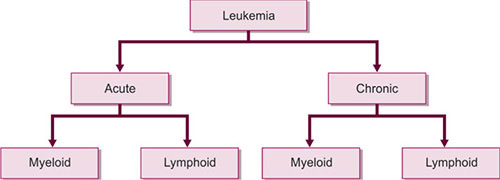Leukemia
Subject: Medical and Surgical Nursing I (Theory)

Overview
One type of white cell and its producers proliferate abnormally, uncontrollably, and in a fatal neoplastic disease that affects the blood-forming tissues. Anemia, leukopenia, the production of immature cells, thrombocytopenia, and a decrease in immunity are all symptoms of leukemia that affect the bone marrow.
Classifications
Leukemia is divided into a number of large groups according to the cell type and the time since the onset of the disease.

Pathophysiology
Characterized by:
- Diffuse leukemic cell replacement of bone marrow
- Abnormally immature white blood cells are seen in the peripheral circulation.
- Throughout the body, there is widespread infiltration of the lymph nodes, liver, spleen, and other tissues.
- Leukemic cells are young, migratory, and poorly differentiated, and they are also able to proliferate quickly and live for a very long time.
Symptoms
Signs and symptoms that indicate a lack of blood loss include:
- Excessive white blood cells Infections
- Few red blood cells-Paleness (anemia)
- Few platelets-Excessive bleeding.
Night sweats, weakness and weariness that don't improve with rest, accidental weight loss, bone pain and tenderness, painless swelling of the lymph nodes (particularly in the armpits and neck), hepatomegaly, and splenomegaly are common signs and symptoms. Ecchymosis with purpura. Fever, chills, easy bruising and bleeding, and frequent infections
Leukemia may also manifest as symptoms in organs that have been invaded or impacted by cancer cells, such as the liver. Headaches, nausea, vomiting, disorientation, loss of muscle control, and seizures can all be brought on by the CNS. Anemia, infections, attacks on the immune system, and general weakness are all repercussions of eukemia on the body. Regular white blood cells, red blood cells, and platelets are gone, and blasts clog the bone marrow and bloodstream.
Diagnosis
- Personal and family medical histories make up history.
- Physical examination: petechia, pale skin and mucous membranes, enlarged lymph nodes, splenomegaly or hepatomegaly.
- Blood tests: CBC, WBC, platelets, and hemoglobin fall
- Biopsy:
- Bone marrow aspiration: A large, hollow needle is used to extract bone marrow samples.
- Bone marrow biopsy: A very thick, hollow needle is used to retrieve a tiny bit of bone and bone marrow.
- Other Tests:
- Chromosomes of cells from blood, bone marrow, or lymph node samples are known as cytogenetics. For instance, the Philadelphia chromosome, an aberrant chromosome, is present in CML patients.
- Chest x-ray
Management
The primary factors influencing treatment selection are leukemia type (acute vs. chronic), age, metastasis, and disease characteristics. Leukemia patients can choose from a variety of treatments, including:
- Attentive waiting
- Immunotherapy
- Chemotherapy
- Radiation therapy
- Transplanting bone marrow
Nursing Management
Nursing interventions also depend on the disease's clinical manifestation, the treatment, coping mechanisms, the patient's or family's preferences, and the availability of support systems. The shared objective and treatments are:
- To prevent infection brought on by neutropenia:
- Keep an eye out for infection signs
- Start the measures for protective isolation.
- For every procedure, strictly adhere to aseptic technique.
- Strict cleaning of hands
- Remove all fresh or raw produce from the diet, fresh flowers from the client's room, and any standing water from the room.
- Abstain from intrusive procedures
- Check the color and clarity of the urine.
- Evade crowds
- Administering prescribed drugs
- Give the customer information on a low-bacteria diet and tell them not to consume water that has been sitting for more than 15 minutes.
- Tell the client to refrain from doing things like changing a pet's litter box, working with houseplants, or working in the garden if they could expose them to an infection.
- Informing clients not to acquire a live vaccine for themselves or their household connections
- Preserve good personal hygiene
To reduce the risk of bleeding: The client is at risk for bleeding if their platelet count is under 50,000 cells/m3, and they frequently experience spontaneous bleeding. occurs when there are fewer than 20,000 cells/mm3 of platelets:
- Observe for any symptoms of bleeding.
- Use blood products as directed.
- Treat the client with care.
- Bed and furniture sharp corners and side rails should be padded.
- Dispense soft foods
- Avoid injections if at all possible, and press gently but firmly on the site of a needle poke for at least 10 minutes.
- Avoid using thermometers, enemas, and rectal suppositories.
- Count the number of pads or tampons used by the female client.
- Tell the patient not to use dental floss and to use a gentle toothbrush. Specify to the patient:
- Shave only using an electric razor.
- Do not blow your nose.
- Avoid wearing or wearing shoes that are too tight.
- Avoid using NSAID and aspirin-containing products.
- Encourage the client to refrain from using sharp objects in any activity.
- To maintain a healthy diet and lessen fatigue:
- Help the client choose a diet that is well-balanced
- Give little meals frequently (little chewing)
- Provide enough time for rest.
- Nursing care is given in accordance with the patient's needs (if chemotherapy, radiation therapy suggested)
- Offer psychiatric assistance
- Specify home care:
- Proper oral care
- Observe blood transfusions
- Shield yourself from infectious sources
Things to remember
© 2021 Saralmind. All Rights Reserved.

 Login with google
Login with google